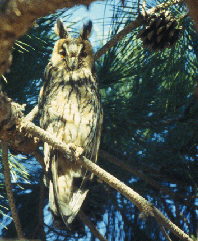

RECORDING 1
DATE/TIME: 16/july/2005 (11.30 p.m.) - IDENTIFICATION AND BEHAVIOUR: The bird - not seen - is perched in a pine copse near the bank of the Orbetello lagoon - POSITION: Patanella copse near Orbetello lagoon, LAT.N 42°27'/LONG.E 11°13' - ALTITUDE: 0 m. - VOCALIZATION TYPE: call of a recently fledged young. - SEX/AGE: fledged young of unknown sex. - COMMENT: time interval between calls has been reduced in the spectrogram and the in the audio sample. True interval between calls = about 9 s. - MIC: (A)
recording 1 (223 KB) - * - spectrogram 1 (86 KB)
RECORDING 2
DATE/TIME: 22/march/2003 (7 p.m.) - IDENTIFICATION AND BEHAVIOUR: One male - not seen - is perched far away in a wood surrounded by cultivated land. - POSITION: Poderone near Magliano in Toscana, LAT.N 42°36'/LONG.E 11°17' - ALTITUDE: +130 m. - VOCALIZATION TYPE: territorial call. - SEX/AGE: adult male. - COMMENT: The bird was far from the microphone, therefore the sound sample is amplified and filtered. - MIC: (A)
recording 2 (380 KB) - * - spectrogram 2 (28 KB)
RECORDING 3
DATE/TIME: 10/july/2007 (11.30 p.m.) - IDENTIFICATION AND BEHAVIOUR: There are at least two recently fledged young in the copse. The female is patrolling her territory in flight. She calls several times. - POSITION: Patanella copse near Orbetello lagoon, LAT.N 42°27'/LONG.E 11°13' - ALTITUDE: 0 m. - VOCALIZATION TYPE: alarm calls in flight. - SEX/AGE: adult female. - COMMENT: The bird is probably alarmed by my presence. It flies two times over my head calling loudly. Time interval between calls has been reduced in the audio sample and in the spectrogram. True average interval: 11 s. (S.D. = 1.8; range = 8/12; n=4) - MIC: (P)
recording 3 (416 KB) - * - spectrogram 3 (76 KB)
RECORDING 4
DATE/TIME: 10/july/2007 (11 p.m.) - IDENTIFICATION AND BEHAVIOUR: Same birds in the same place as above. - POSITION: Patanella copse near Orbetello lagoon, LAT.N 42°27'/LONG.E 11°13' - ALTITUDE: 0 m. - VOCALIZATION TYPE: calls of recently fledged youngs. - SEX/AGE: fledged young of unknown sex. - COMMENT: The young birds call almost continuously (background: Scops owl and crickets). Time interval between calls has been reduced in the spectrograms, but not in the audio sample. Average interval between calls: 2.8 s. (S.D. = 1.3; range = 0.8/6.4; n=47) - MIC: (P)
recording 4 (398 KB) - * - spectrogram 4 (76 KB)
RECORDING 5
DATE/TIME: 4/june/2010 (9.30 p.m.) - IDENTIFICATION AND BEHAVIOUR: At least two fledged young birds (not in sight) are perched at the border of a forest. - POSITION: Poderone near Magliano in Toscana, LAT.N 42°36'/LONG.E 11°17' - ALTITUDE: +130 m. - VOCALIZATION TYPE: calls of fledged youngs (two different types). - SEX/AGE: fledged young of unknown sex. - COMMENT: The closest bird utters a typical long wailing call, while the farther bird utters a sequence of short plaintive syllables. This audio sample is part of a longer recording. See spectrogram time axis for true intervals. Background: Nightingale, Nightjar, amphibians. - MIC: (P)
recording 5 (490 KB) - * - spectrogram 5 (172 KB)
RECORDING 6
DATE/TIME: 4/june/2010 (9.35 p.m.) - IDENTIFICATION AND BEHAVIOUR: Same place and same birds as above (not in sight). - POSITION: Poderone near Magliano in Toscana, LAT.N 42°36'/LONG.E 11°17' - ALTITUDE: +130 m. - VOCALIZATION TYPE: calls of fledged youngs and female calls. - SEX/AGE: fledged young of unknown sex and adult female. - COMMENT: Two young owls call almost continuosly. One is closer to the recordist, the other is farther and sometimes the calls are superimposed (see spectrograms). The adult female is far and calls three times with a barking sound. This audio sample is part of a longer recording. Background: Scops owl, Nightingale. - MIC: (P)
recording 6 (396 KB) - * - spectrogram 6 (188 KB)
RECORDING 7
DATE/TIME: 4/june/2010 (9.45 p.m.) - IDENTIFICATION AND BEHAVIOUR: Same place and same birds as above (not in sight). - POSITION: Poderone near Magliano in Toscana, LAT.N 42°36'/LONG.E 11°17' - ALTITUDE: +130 m. - VOCALIZATION TYPE: calls of fledged youngs. - SEX/AGE: fledged young of unknown sex. - COMMENT: Two young owls call almost continuosly. One is closer to the recordist, the other is farther. Note the slight difference, but noticeable, in pitch and in frequency modulation between the two young birds (see spectrograms). To point out this difference I have amplified the first four calls of the farther bird. This amplification has been performed only in the spectrogram, but NOT in the audio sample. Background: Scops owl, Nightjar and amphibians. - MIC: (P)
recording 7 (474 KB) - * - spectrogram 7 (110 KB)